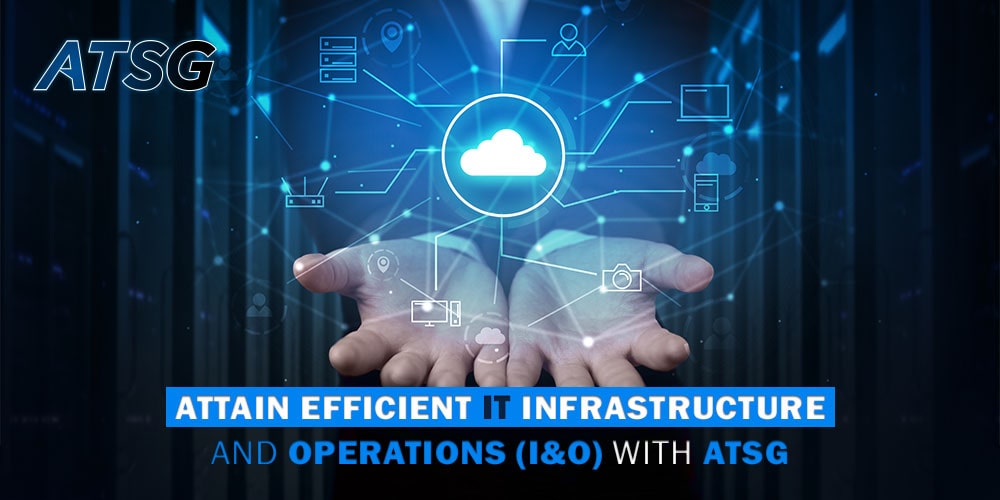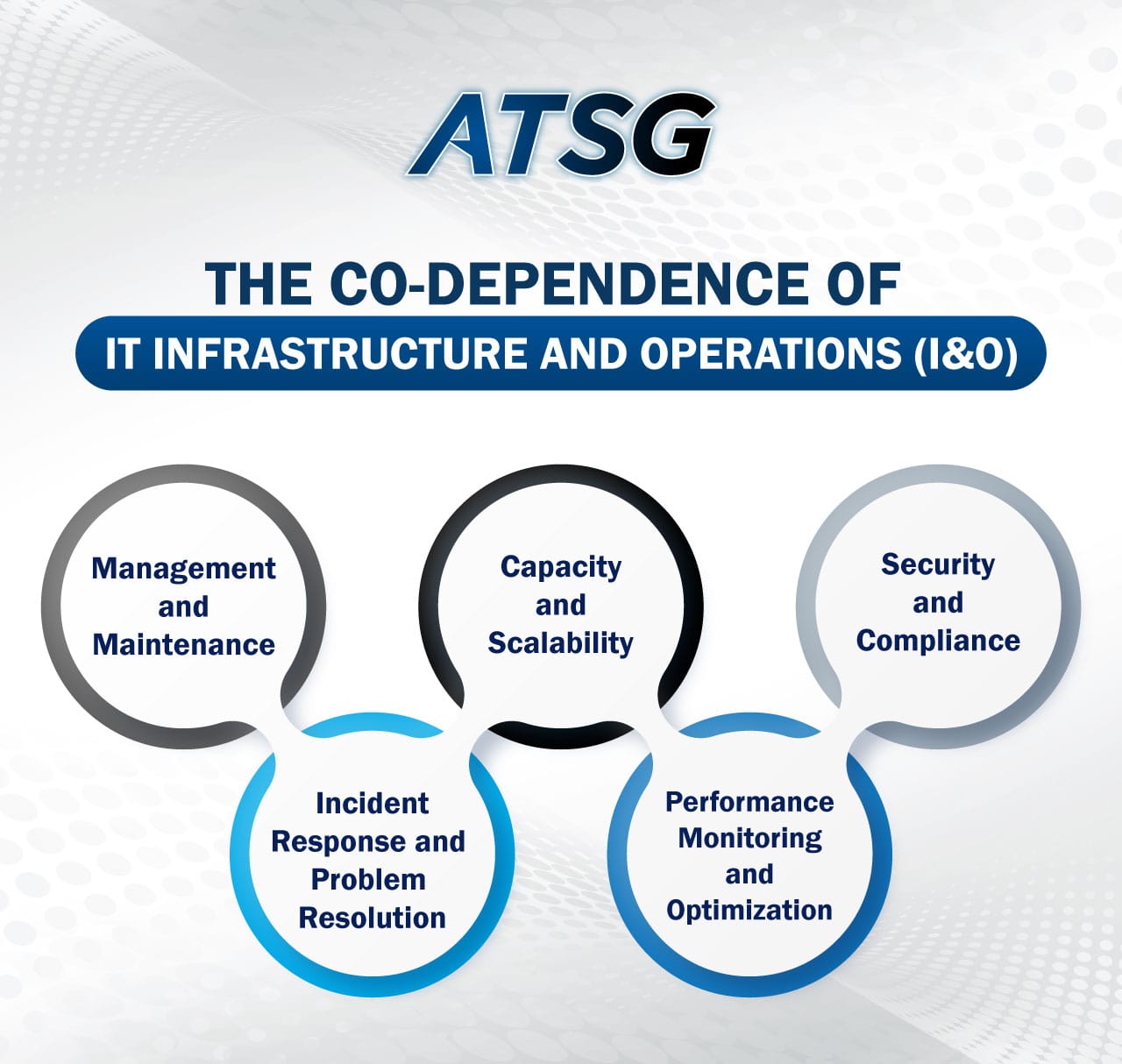IT is becoming a key component of an organization’s value stream, necessary for developing and improving products and services, and for maintaining the value proposition of an entity.
There are several domains within an organization’s information technology department, such as IT Infrastructure and IT operations (I&O). Each of these plays an essential role in ensuring that technology operates efficiently, and supports the changing needs of a business.
Learning about each of these areas helps organizations understand their technological pathways. One of the critical aspects of this article will be opting for ATSG as a refined solution to IT operations and IT infrastructure.

What is IT infrastructure?
IT infrastructure is the collection of hardware, software and technology that provides a foundation for a company’s IT services. This can include company devices like laptops and desktops, databases, software, and servers. IT infrastructure can be deployed with a cloud computing system, or within an organization’s own infrastructure. These components include hardware, software, networking components, an operating system (OS), and data storage, all of which are used to deliver IT services and solutions.
Understanding IT Operations
The term IT operations describes the services and management of a company’s IT department. IT operations support all the technology in a company’s IT infrastructure, including device and software support. These operations can include the processes and services that allow a business to run smoothly.
The key components of IT operations include the following:-
- Running Solutions: IT operations involve frequently running solutions to solve problems and ensure operating technologies and support services meet business requirements.
- Managing IT Infrastructure: IT operations help oversee the operation of hardware, software, and devices deployed across the business.
- Managing Configurations: Managing configurations means ensuring all technical equipment and infrastructure work together so users can easily operate them.
- Developing Infrastructure: Developing infrastructure means continually updating software and devices to meet the latest technology trends.
- Managing Risks and Issues: IT operations manage risks and issues to ensure different software have adequate safety features enabled to protect both user and sensitive company information.
- Governing Operations: Means overseeing how a staff executes each component of IT operations.
The Co-Dependence of IT Infrastructure and Operations (I&O)
IT operations and IT infrastructure are closely interconnected and dependent on each other to ensure the smooth functioning of an organization’s IT environment. The interplay between IT operations and infrastructure can be understood as follows.

Management and Maintenance
IT operations teams are responsible for managing and maintaining the IT infrastructure. They oversee tasks like installing, configuring, and updating hardware and software, monitoring system performance and troubleshooting issues. Effective IT operations ensure that the infrastructure remains operational, secure, and optimized.
Incident Response and Problem Resolution
When issues or incidents occur within the infrastructure, IT operations teams are responsible for identifying and resolving them. They utilize their knowledge of the infrastructure to troubleshoot problems, perform root cause analysis, and implement corrective action. This collaboration ensures that disruptions are minimized, and systems are restored to normal functionality as quickly as possible.
Capacity and Scalability
IT operations work closely with IT infrastructure teams to determine the capacity requirements of the infrastructure. By monitoring system usage and performance, they can identify bottlenecks and anticipate future needs. This information is crucial for IT infrastructure teams to plan for capacity upgrades, procure additional resources, and ensure that infrastructure can scale to meet the organization’s demand.
Performance Monitoring and Optimization
IT operations teams continuously monitor the performance of the IT infrastructure, collect data, utilization stats, response times, and other key metrics. This information helps identify areas for improvement and optimization. IT infrastructure teams can then use these statistics to fine-tune the infrastructure, optimize resource allocation, and ensure optimal performance as well as reliability.
Security and Compliance
IT operations and infrastructure teams collaboratively implement robust security measures to ensure compliance with industry standards and regulations. They work together to configure firewalls, implement access controls, apply security patches, and monitor security incidents. Coordination between the two teams helps maintain a secure infrastructure and protect sensitive data from breaches and un-authorized access.
Effective Ways in Managing Operational Stability
The key to improving an organization’s operations, productivity levels, and Return on Investment (ROI) is by enhancing the stability of operations. Operational stability stands as one of the most critical issues IT organizations face today, and will continue to do so in the future as well.
Businesses utilize IT services to be able to provide customers with efficient and memorable experiences, which means these services need to be stable and reliable. In today’s rapidly changing marketplace, the pace of change necessitates services being redefined, eliminated, or reinvented.
Regardless of the service to the business, IT organizations provide the business operational stability with three guiding principles:-
1. Less is More: The fewer the components, hardware vendors, service providers, and contracts that require to be changed, lesser is the chance of operational failure.
2. Sound Enterprise Architecture: IT architecture is a complex array of technology platforms that include equipment, interconnectivity, and other components that must work in harmony for the business to run efficiently.
3. Change Management Process: IT operations teams want to improve existing processes, but this exercise needs to be formally documented. This is where the role of change management processes comes into play.
Class Leading I&O Solutions by ATSG
With the advent of technological solutions, IT Infrastructure and Operations (I&O) are becoming more complex and distributed than ever. Finding third-party vendors that provide refined services can be a challenge for organizations seeking operational stability and management. This is where ATSG shines with its intelligent technology solutions that are suitable and customizable as per various IT environments.
ATSG is one of the most refined IT and Technology solutions providers that endorses the development of IT infrastructure and operations. The ATSG OPTX platform is designed to help businesses maintain service availability, ensure quality, and improve operational stability for multiple environments.
ATSG OPTX offerings deliver a comprehensive monitoring and management solution that improves, and networking environments. ATSG also offers versatile technology solutions that cater to diverse business requirements, and provide tools that would advance IT infrastructure and operations management.




